
Willows, also called sallows and osiers, from the genus Salix, comprise around 400 species of typically deciduous trees and shrubs, found primarily on moist soils in cold and temperate regions.

Salix alba, the white willow, is a species of willow native to Europe and western and central Asia. The name derives from the white tone to the undersides of the leaves.

Salix purpurea, the purple willowpurpleosier willow or purple osier, is a species of willow native to most of Europe and western Asia north to the British Isles, Poland, and the Baltic States.

Androsace, commonly known as rock jasmine, is a genus of flowering plants in the family Primulaceae, second only to Primula in the number of species. It is predominantly Arctic–alpine, with many species in the Himalayas, the mountains of central Asia, the Caucasus, and the southern and central European mountain systems, particularly the Alps and the Pyrenees.

Salix myrsinifolia, known as the dark-leaved willow or myrsine-leaved willow, is a species of willow native to Europe and Western Siberia. It forms a 2–5 m (6.6–16.4 ft) high shrub. In the north it often becomes a tree up to 8 m (26 ft) tall.

Carex morrowii, the kan suge, Morrow's sedge, Japanese grass sedge or Japanese sedge, is a species of flowering plant in the family Cyperaceae. It is native to central and southern Japan, and has been introduced to Belgium, Denmark and Austria.
Sinojohnstonia is a genus of flowering plants belonging to the family Boraginaceae.

Rubus xanthocarpus is a species of flowering plant in the raspberry genus Rubus, family Rosaceae. It is native to central and southern China, and has naturalized in Poland and the former Czechoslovakia. It is available from commercial suppliers. The orange-yellow fruit are edible, taste similar to raspberries, and can be eaten raw or made into preserves or wine.
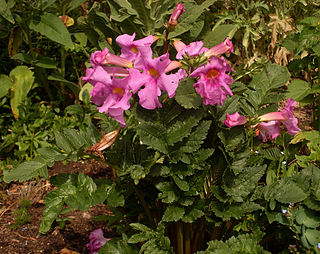
Incarvillea delavayi, the so‑called hardy gloxinia or flowering fern, is a species of flowering plant in the family Bignoniaceae, native to western Sichuan and northwest Yunnan provinces of China. The true Gloxinia are members of the Gesneriaceae, while true ferns are flowerless plants which reproduce through spores.

Cotoneaster cochleatus, the Yunnan cotoneaster, is a species of flowering plant in the family Rosaceae. It is native to rocky slopes in Tibet, Sichuan, and Yunnan in China, and it has been introduced to the United Kingdom, Belgium and New York State. Its specific epithet cochleatus refers to its twisting stem.

Salix alpina, the Alpine willow, is a species of flowering plant in the family Salicaceae, native to the Eastern Alps and the Carpatians, with one station in the Dinaric Alps. A creeping, mat-forming deciduous shrub, it is available in commerce. Its growth habit varies according to local conditions.
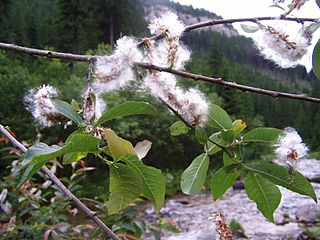
Salix silesiaca, the Silesian willow, is a species of flowering plant in the family Salicaceae. It is native to the Sudeten and Carpathian Mountains, and the mountains of the Balkan Peninsula. A shrub reaching 6 ft (2 m), it is considered to be a member of the informal sallow group.
Salix fruticulosa is a species of flowering plant in the willow family Salicaceae, native to Nepal, the eastern Himalayas, and Tibet. It is common in sub-alpine silver fir–birch forests from 2,800 to 3,800 m. Although there may some confusion about which species of dwarf willow is intended, Salix fruticulosa is listed by the Royal Horticultural Society as available from commercial suppliers.
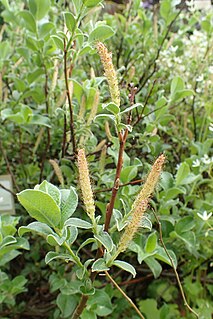
Salix pyrenaica, the Pyrenean willow, is a species of flowering plant in the family Salicaceae, native to the Pyrenees and Cantabrian Mountains. A shrub or subshrub with procumbent main stems, and ascending branches usually reaching 1.5 ft (0.5 m), it is occasionally available in commerce.

Salix uva-ursi, the bearberry willow, is a species of flowering plant in the family Salicaceae, native to subarctic and subalpine parts of northeastern North America and Greenland. A prostrate shrub, the extreme southern edge of its range is high in the mountains of northern New England.
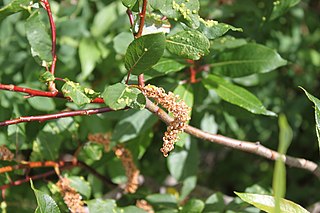
Salix pyrifolia, the balsam willow, is a species of flowering plant in the family Salicaceae, native to Canada, and the north-central to northeastern United States. A shrub, its leaves emit a balsam-like fragrance. It is available from commercial suppliers.

Scabiosa japonica is a species of flowering plant in the pincushion flower genus Scabiosa, native to central and southern Japan, and introduced to the Dominican Republic. A biennial or short-lived perennial reaching 10 to 50 cm, the Royal Horticultural Society considers it a good plant to attract pollinators. A number of cultivars are commercially available, including 'Blue Note', 'Blue Star', 'Blue Diamonds', 'Ritz Blue', and 'Ritz Rose'.

Salix × rubra, the green-leaved willow or red osier, is a naturally occurring hybrid species of flowering plant in the family Salicaceae. It is the result of crosses between Salix purpurea and Salix viminalis. It is native to a large part of Europe, found where the parent species' ranges overlap. The straight, flexible stems are prized by basketmakers. There are a number of cultivars, with the fastigiate 'Eugenei' being the best known.
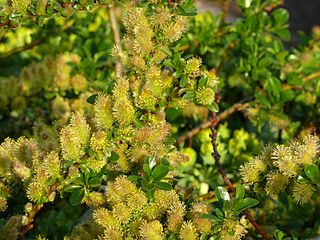
Salix apoda, the Caucasian willow, is a species of flowering plant in the family Salicaceae, native to the Caucasus and northern Turkey. A prostrate shrub, it is occasionally cultivated as an ornamental ground cover in rock gardens, particularly the males, since they produce large, silvery catkins that then erupt in yellow stamens.




















